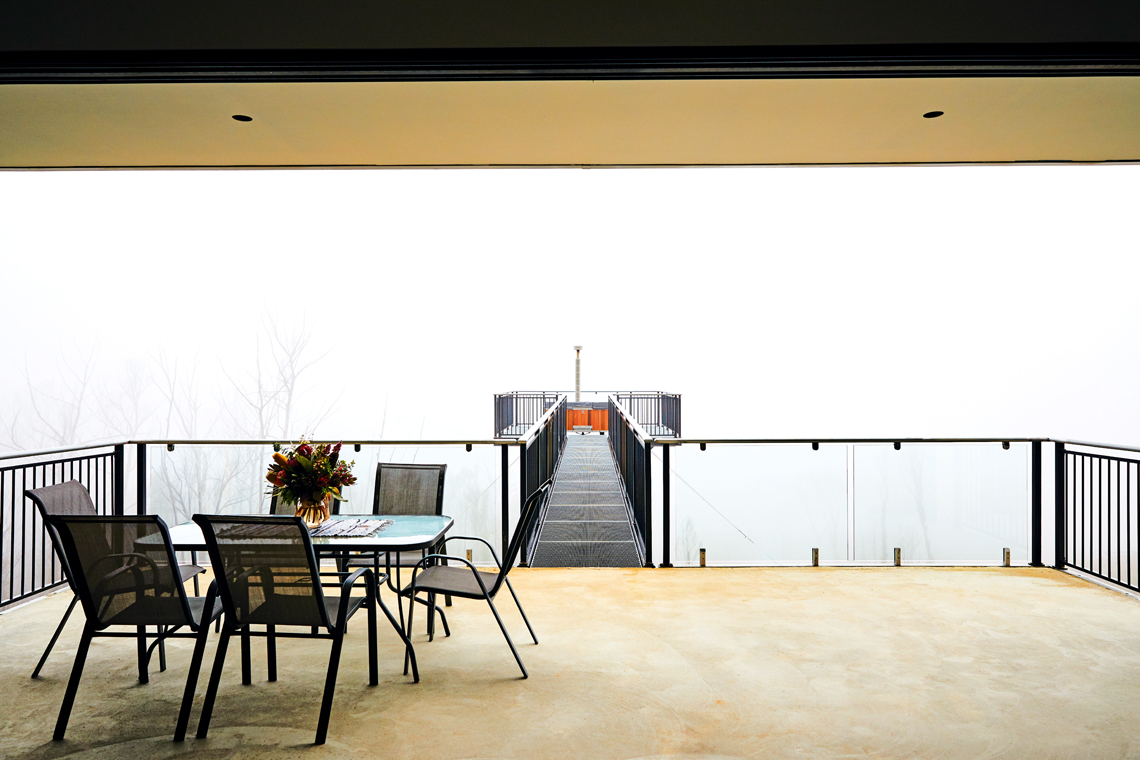Driving down the steep, rutted mountain track and encountering a derelict caravan and rugged bushland might have made some people turn back. But not Dennis and Karen Jones. They could see the potential and spectacular views that were ripe for the picking, eventually leading to the creation of Clarence House. The block was also in a bushfire-prone area. It was purchased in 2013, and before settlement, raging bushfires swept through.
“We returned to a vastly different block enveloped in an unnerving stillness, blackened and devoid of life,” recall Dennis and Karen. “The loss came with a blessing as the fire had burnt the dense undergrowth, opened the valley and blue mountain views, and suddenly our dream to retire in a beautiful spot became more real.”

They needed a home that was robust and nearly indestructible to withstand the very real threat of further bushfires, high winds, snow, extreme cold, and high altitude. Consequently, the idea of a container home was born. Dennis then began to research and plan what their future abode might look like. “The hundreds of hours of teeth-grinding are a testament to the thought and engineering Dennis put into every aspect of the build,” says Karen.
The couple, empty nesters in their 60s and nearing retirement, wanted a home that was supremely self-sufficient. “The only house bill we were prepared to accept was rates,” they say. Therefore, a house made of containers became an innovative concept. The home consists of seven 40ft-high cube containers and features five different levels. Karen and Dennis explain that five of the containers are stacked like Jenga blocks to create a large atrium. Meanwhile, “the sixth is upright and serves as the spine of the home, encasing the stairs up to a viewing platform at the very top,” they share. Furthermore, container number seven is also upright, supporting the external deck and a 12m-long walkway.

The design changed early in the process when the team decided to install a full basement. “However, once the final DA went through, there were no changes and the design stayed true to Dennis’s first vision,” says Karen.
The basement of Clarence House houses the Tesla battery system, hot water, and storage pumps. Additionally, the atrium fills with light, featuring huge glass sliding doors and a ceiling that seems to touch the sky. On one side, there is a fireplace, while on the kitchen side, a wood-fired oven completes the space.
The container on the right-hand side of the atrium houses the office, and there’s also a home theatre in a style reminiscent of their hometown in New Zealand.

On level three, the bedrooms include a master and two smaller additional bedrooms. Moving up to level four, the garden view boasts two large triangular windows that allow for airflow and ventilation. Meanwhile, the top level offers a viewing platform with views guaranteed to take your breath away.
The more you explore, the more the many layers of this spacious and impressive home are revealed. There are quirky touches too, including a “Dennis special” dummy waiter-style elevator down to the basement for easy loading of firewood.
Moreover, the home’s design carefully orients and captures the views, harnessing light and its subtle nuances at different times of the day.
The project, however, was not without its share of challenges. Among them were the many hoops the couple had to jump through as owner-builders and the task of constructing an off-grid house on a steeply sloped site. “It took months to get the DA through council and long delays due to severe weather, a shortage of tradesmen, Dennis’s health, and the loss of both our dads in that time,” says Karen. “Nevertheless, together we got through it, and we couldn’t be happier and prouder of our achievement.”

















